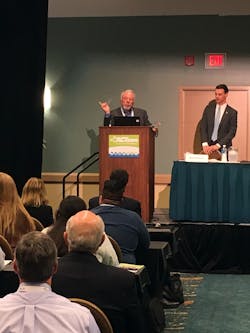No, the $100,000-a-year truck driver is not just an urban legend. And that driver exists beyond working on a dangerous “ice road” or traveling through a war-torn nation.
“I would not call a $100,000 earner the norm, but they are becoming common in the private fleet,” said Leah Shaver, vice president at the National Transportation Institute (NTI), Hudson, WI.
The group, which has tracked driver pay for more than two decades, has seen annual trucker wages “for years at and above the $80,000 range,” including at many for-hire fleets.
For the majority of truck drivers, pay remains well below these levels. The Bureau of Labor Statistics (BLS) lists the median annual wage for heavy-duty and tractor-trailer drivers at $41,340.
“I don’t think drivers are compensated enough today. Trucking companies are not compensated enough either, unfortunately,” said John Elliott, CEO of Load One, an expedited carrier based in Michigan.
“The overwhelming answer is no,” added Norris Beren, CEO of Risk Reward Consulting in Chicago, when asked if truckers are paid enough.
Officials interviewed by Fleet Owner agreed the driver shortage and changing workforce demographics are forcing fleets to consider bigger compensation packages, career advancement opportunities, and other nontraditional assistance.
There is also a growing willingness to experiment with pay structures beyond the predominantly used per-mile method. Those include tailored pay packages to specific regions, pay guarantees, and hourly pay. Shaver explained hourly pay is small in the overall driver pay market, but is its fastest growing segment.
“Do we believe hourly pay would be disastrous for the industry? Absolutely not,” she emphasized.
For Greg Reisnaur, a long-time trucker turned owner of Elite Truck School in Hillsboro, OR, the overall U.S. unemployment rate—and not driver pay—is the best indicator of how many students to expect in the coming months.
With the jobless rate hovering around 4.5%, the lowest level in about a decade, even $7,500 sign-on bonuses from select recruiters “didn’t change the threshold one bit. I didn’t get any more calls,” Reisnaur said.
For those who do enroll, he emphasizes the true value of a commercial driver’s license.
“Four weeks, $4,000, and you have a skilled trade and you are going to go out the door making better than 20 bucks an hour,” Reisnaur noted.
Victor La Rosa, president and CEO of Total Transportation Services Inc. (TTSI), Rancho Dominguez, CA, offered similar advice. “The first thing to say to [new drivers] is to get as many certifications as they can get,” he said. “More certifications mean more opportunities.”
Elite’s Reisnaur called his own career path “accidental, but not unusual.” Tutored in Idaho to drive trucks by his girlfriend’s stepfather at the age of 19, he ended up spending several years hauling different kinds of freight before joining Consolidated Freightways (CF) in 1986.
Reisnaur noted that he made it as far as systems operations manager, then CF went out of business in 2002—the event that set him on a new and unexpected course (see sidebar at right).
“That’s the beauty of the trucking industry. It’s kept me in it because there are all these jobs I’ve gotten to do,” he pointed out.
On a recent visit to Reisnaur’s school, a dozen students were halfway through the four-week course. Two of the younger drivers said they believed becoming a truck driver would provide them with better opportunities.
Reisnaur and the school’s trainers prepare students for transition from the classroom to the real world.
“They may want to go over the road but discover they don’t like it,” Reisnaur said. “I tell them, ‘That is okay. You can get another driving job. There are all kinds of driving jobs out there.’"
If students decide truck driving is not the right career path, though, it likely will not be because of money, stressed Tim Hindes, CEO of management consulting firm Stay Metrics, South Bend, IN.
Research shows only about 20% attribute their decision to leave a carrier primarily to money, he emphasized.
Similar carriers with nearly identical pay rates often have wide variances in turnover rates. In addition, a high percentage of drivers leave within the first six months, well before raises and other compensation kick in.
All of that leads Hindes to rhetorically ask about why drivers leave. “How can it be pay?”
Shaver classified the old style of hiring drivers as “churn and burn,” and said it is not working.
Everyone interviewed for this story agreed there is a need for greater honesty during the recruitment and orientation process; that is what can prevent distrust and disappointment from developing if financial expectations are not initially met.
Fleets should also do a better job providing “clear, up front, realistic expectations” when it comes to compensation, miles and routes, added Load One’s Elliott.
Risk Reduction’s Beren, being more direct, noted that “drivers are entitled to a complete written description of their compensation plan when they start.” He criticizes firms that advertise making $80,000 in the first year, a figure that does not accurately take into account charge backs and other fees.
Feedback from drivers to Stay Metrics backs up these points. “Don’t lie to us,” Hindes stressed in a summation of what he hears during driver forums.
Beyond traditional pay increases, more fleets are showing greater “creativity” with compensation methods, added Beren. Bonuses for boosting fuel mileage or extending brake life are ways fleets are showing drivers “they are a partner,” he noted.
Elliott suggested fleets should also do a better job of explaining to drivers how they benefit from a company’s investment in equipment. For example, Load One purchases modern trucks and spends thousands of dollars on technology. That is aimed at boosting the productivity and safety of drivers, which helps them maximize their income potential, he said.
Across the industry, health insurance, retirement saving plans, tuition reimbursement, paid time off, and even commuter benefits are slowly becoming part of many truck drivers’ overall compensation plans.
Fleets are also recognizing a need to shift with a changing work environment.
“The trucking industry has not focused on developing the career-conscious driver,” Hindes explained during a conference call late last year. “Driver pay rates have been set by the market rather than based on experience and competence, and drivers have little loyalty to a particular employer, since they can obtain comparable pay and benefits with any number of fleets.”
In some cases, this means offering better routes and equipment with longevity. For others, it is a path from driving to a training or safety management position as their career progresses.
“This nontraditional workforce is hungry for traditional job progression and advancement,” stressed NTI’s Shaver. Elliott and La Rosa were quick to point out that many owner-operators are content with owning their own small businesses. That does not mean companies using independent contractors can’t find ways to help them maximize income, added Hindes.
“Owner-operators can have a difficult time managing their businesses,” he pointed out. “They are good drivers, but not necessarily good businessmen.”
Hindes offered several suggestions to help retain them, including putting weekly earnings above a certain threshold into an escrow account.
“That can be attractive to drivers who are sick and tired of riding the valleys” of volatile freight, he noted.
With projections of higher tonnage levels and a growing driver shortage, there is optimism carriers will be able to raise rates. “The key here is making sure drivers benefit from the increase in rates,” Beren said.
Still, tight economic margins for truckers are unlikely to change. That is where groups like ONE20 come into play, whose mission is to help truckers “capture savings.”
By reducing expenses eating into top-line revenue, the result is “a raise in take-home pay,” noted ONE20 CEO Christian Schenk. A veteran of the trucking technology space, Schenk founded ONE20 in 2015, which he explained is a platform that exists to “harness the collective voices” of truck drivers.
Schenk expressed frustration with how much truck stops mark up prices on fast food and everyday necessities, noting that truckers save on average 38% when ordering products on Amazon.com, compared with a typical travel center.
“There is an opportunity to recognize these people as the catalysts and enablers of commerce as we know it, and we should not be charging them more for this; we should be charging them less,” he pointed out.
That is exactly what ONE20 is trying to do: get truckers discounts on food, tires, financial services, and other products. The company also aims to provide access to free or low-cost technologies like truck-specific navigation and electronic logs as well as fitness videos and nutritional products.
Schenk encourages fleets to subsidize the cost of eating healthy, which is more expensive than fast food. In fact, more fleets are paying for gym access and providing health incentives as further ways to achieve greater overall performance while helping truckers save money.
While it might not add up to a $100,000 a year paycheck, they are nevertheless taking small steps toward what NTI’s Shaver described as a “central question” all fleets should be asking themselves: “How can we add value to drivers’ careers and make it clear to them we are doing that?”
In one year, two generations turn to trucking
Kaleb Haynes, 22, had been searching for the right career path in the year since completing a four-year stint with the U.S. Marine Corps. The Vancouver, WA, resident had tried several jobs. At the same time, his father was stepping away from a 30-year career in the construction industry to begin a new chapter as a trucker.
“He always wanted to be a driver,” Haynes said.
Haynes’ father obtained his commercial driver’s license (CDL) after completing training at Elite Truck School in Hillsboro, OR, and is now with a local flatbed company.
Around the same time, Haynes discovered he would become a first-time father later this year, creating a sense of urgency to find the right job.
Haynes talked it over with his father, who told him about the job opportunities available in trucking. “He put his résumé out and companies are fighting for him rather than fighting with 500 other people for one job position,” he said.
That convinced Haynes to follow in his father’s footsteps and enroll at Elite Truck School. “I want to jump into trucking because of the money and the opportunities with how low they are with drivers,” he said. “It seems like a career where how much you put into it is what you get out of it.”
Haynes said he hopes to land a local job, so he can be around more often after the birth of his child. He knows that still means time away from home and potentially working odd hours. Yet, he quickly has come to the realization of the value of obtaining his CDL.
“This is my ‘Plan A’ right now but could become ‘Plan B’ if I want to jump into something else,” said Haynes, adding that he knows he can always jump back into a truck in the future.
Even a Five-Hour Commute Cannot Stand in the Way
Halfway through this four-week commercial driver’s license training program, Fernando Uloa’s dedication to become a truck driver could not be questioned. His round-trip commute between his home in Hood River, OR, and Elite Truck School in Hillsboro, OR, clocked in at more than five hours.
It is well worth it, Uloa explained, for the opportunities he sees ahead for him, his wife and two daughters.
“There are a lot of jobs for people with CDLs,” he said. “It offers me a way to make more money.”
Born in Mexico, Uloa moved to Texas in 2000 and later settled in Hood River, near where his wife grew up. He’d been a forklift operator in a local warehouse and would often speak with truckers making deliveries about their experiences.
“I would ask them a lot of questions, and they would tell me I could make good money driving trucks,” he emphasized. “Some guys said, ‘No. Don’t do it. It is hard and you could be away from your family for a long time.’”
Despite those warnings, Uloa remained interested in switching careers. He then took the advice of one long-time driver.
“If you don’t try, you won’t know if it is good or not,” Uloa said that driver told him. “I needed to try and I’m still here. I want to try to do it.”
Uloa admitted he still needed to improve his driving skills but couldn’t help but crack a smile as he envisioned the day when he purchases his own truck and launches his business.
“This is going to open more doors in my life,” he pointed out.






